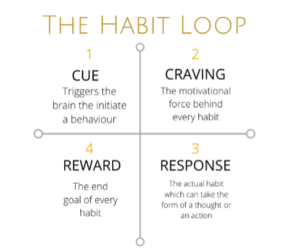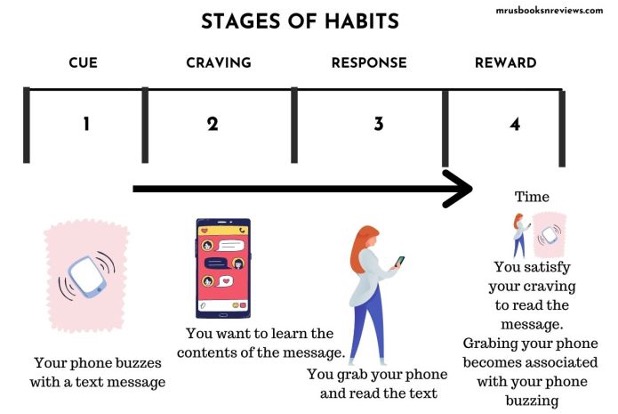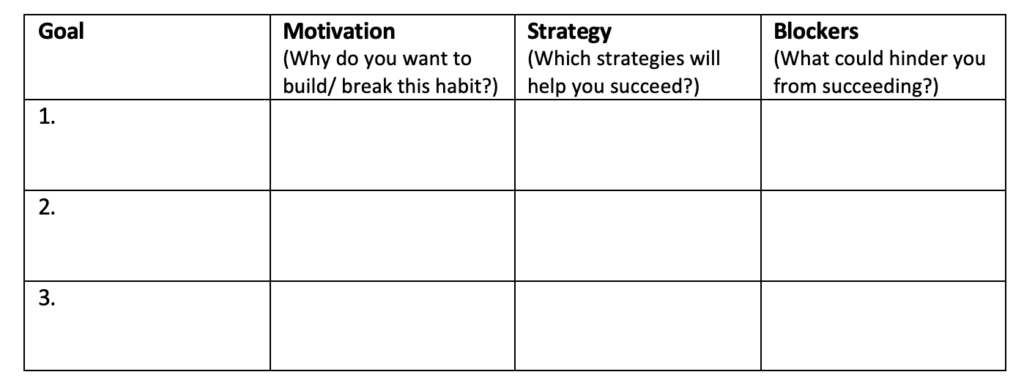At the end of this module, you will:
What is a habit?
Do you scroll through your phone as soon as you wake up in the morning? Do you make time to exercise every day? Is a morning coffee a non-negotiable for you? These are all habits – some you might hate, some you might love – but none of them happened overnight.
To put it simply, habits are thoughts or actions that are repeated enough times that they become automatic.
While some habits can be detrimental, such as wasting an hour on social media when you’re meant to be working, others can be great for your welfare. Learning to brush your teeth when you’re young helps you have good dental health when you’re older. Another example is turning lights off when you leave a room. That habit saves cost on your energy bill, and it probably stops family disputes too!
Now that you’ve signed up to this program (good work!), creating some of the desired changes you want in your life will involve building new and breaking old habits. But don’t worry, we aren’t leaving it all up to you – this module will help you get there!
How are habits formed?
No doubt you have read an article, watched a news segment or been fed an advert on social media that encourages you to “build good habits” or “break bad habits” by using nothing more than sheer grit. But there’s so much more to it than that.
Habits form when new behaviours become automatic and are enacted with little effort or conscious awareness. That’s because “the behavioural patterns we repeat most often are literally etched into our neural pathways.” So how does this happen?
The Habit Loop
Our brains chase dopamine. So when a behaviour comes along that results in a reward, the brain builds a connection between that behaviour and pleasure. The linking of cue, craving, response and reward is how a habit is born. All habits seem to progress through these stages in the same order as described in the writing of James Clear.

Example of a habit loop
The below is an example of a habit loop. When seeking to change habits, it is important to understand the reasons why you engaged in these habits in the first place. Habits are often part of an intricate network of behaviours and reflect our values, good or bad. If we consider the example provided below, we could ask – What is the driving force behind the need to check her phone? Is it because she is looking for a distraction from work? Is it because she doesn’t like to leave people waiting too long? Is the person a new love interest she’s wanting to impress? It could be many things, but the why is important!

Building VS Breaking Habits
We can divide habits into 2 categories: those we want to build or keep because they are helpful to us, and those we want to let go of because they get in the way of our greater happiness. A “good” habit is a behaviour that aligns with your values and brings you closer to where you want to be in life – it serves your overall wellbeing. A “bad” habit is a behaviour that we repeat automatically, that drains our energy, has harmful repercussions on our body or emotions, and goes against what we want for ourselves.
ACTIVITY: What are your habits?
Grab a piece of paper and draw up two columns titled ‘Habits I want to build’ and ‘Habits I want to break’. Jot down a few in each column. Keep them handy for the next section of this module. You might also want to bring them to your next session with one of your Valion team.
TIPS: How to build new habits
It’s easier to build good habits than break bad habits, so let’s nail this part first!
As described above, the latest science into behaviour change shows that building good habits relies on four key stages. Thus to build a new habit, we need to maximise strategies at these four stages:
| To Create a Good Habit | |
|---|---|
| Cue | Make it obvious |
| Craving | Make it attractive |
| Response | Make it easy |
| Reward | Make it satisfying |
To go deeper into this thinking:
- Cue formation – develop an obvious and consistent trigger that will prompt your new desired behaviour ie; leaving runners next to your bed when you wake up for morning runs
- Context – consider the context in which the behaviour will occur, it could be time, location, people ie; setting an alarm in the morning to go for a run because you’re a morning person
- Repetition – commit to how often you will do this new behaviour ie; every second morning
- Rewards – consider how you can reward yourself (without undoing the benefits of the behaviour) ie; the dopamine hit you get after a run!
TIPS: How to break habits
This one is a little tougher, but it’s very doable. Breaking habits conversely relies on the following strategies at each of the four stages:
| To Create a Good Habit | |
|---|---|
| Cue | Make it invisible |
| Craving | Make it unattractive |
| Response | Make it difficult |
| Reward | Make it unsatisfying |
To explore this a little further:
- Cue disruption – Identify what the cue is that triggers you to engage in the unwanted habit and find a way to disrupt it ie; if having your alarm close to your bed prompts you to turn it off and easily skip your run, move it away from you so you have to get out of bed to turn it off – then wallah, you’re up!
- Re-engineering your environment – changing or altering your environment can help break bad habits ie; if you’re tempted to waste time between tasks when you’re on your computer, try working offline to eliminate distraction.
- The 4 Rules of Habit (James Clear) – Like building good habits we can apply the four steps from the habit loop into a practical framework. Following these rules along with the strategies above will help break unwanted habits.
Activity: Let’s Create an Action Plan
Using what you have learned above, thing of some goals you want to achieve that could involve building new, or breaking unwanted habits. Grab a piece of paper and complete the below table (you don’t need to fill it all out). If you would prefer, enter your goals and work through the table with your Valion Team member in your next session.

TIPS: Making habits sustainable
In tangent with the building and breaking strategies above, it is equally important to ensure the feasibility of your goal. A common mistake people make is setting a large goal that incorporates several behaviours to change simultaneously in order for the goal to be achieved. While the goal is certainly achievable, it can appear overwhelming or ‘too hard’ if results seem too far away, the changes required are too many and progress isn’t felt for a long time.
Atomic Habits
Atomic habits are small, repetitive actions that require little effort or motivation to carry out, but which lead to big changes in our everyday lives. Building atomic habits is a great way to build momentum, stick to changes and create lasting habits.
ACTIVITY – Watch a summary of ‘Atomic Habits’
This video is a great way to summarise what you have learned in this module, but also further explains what atomic habits are. It is based on the book ‘Atomic Habits’ by James Clear.
Key Takeaways
Resources and Further Reading
Below are some useful resources (some mentioned throughout this module) to help with building and breaking habits.
- YouTube video on Atomic Habits: https://youtu.be/PZ7lDrwYdZc
- Atomic Habits book by James Clear
- Podcast with Brene Brown: https://brenebrown.com/podcast/atomic-habits-part-1-of-2/
- Habitica gamification phone app to keep you accountable with habits: https://habitica.com/static/home
If you would like to know more about habits, below are some recommended articles. Some of these may be quite technical, so if you have any questions, be sure to write them down and bring them to your next session.
| The (over)use of SMART goals for physical activity promotion: A narrative review and critique
2022. Health Psychology Review. |
|
| A meta-analysis of techniques to promote motivation for health behaviour change from a self-determination theory perspective
2019. Health Psychology Review. |
|
| Do we need to reconsider best practice in goal setting for physical activity promotion?
2018. British Journal of Sports Medicine. |
|
| Healthy through habit: Interventions for initiating & maintaining health behavior change.
2016. Behavioural Science & Policy. |
